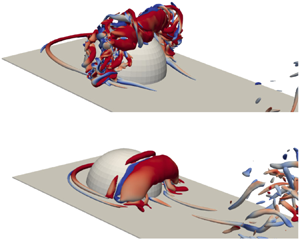Published online by Cambridge University Press: 13 October 2020

Flow pulsatility is ubiquitous in biological and biomedical fluid dynamics. Cardiovascular flow, the most well-studied pulsatile flow, has benefited from decades of fundamental studies of the temporal influences of basic parameter changes in simplified models. A similar approach is employed herein on a relatively unstudied, canonical flow configuration. Using experiments and simulations, we examine highly pulsatile flow over a surface-mounted bluff body. The pulsatile (i.e. with no flow reversal) inflow waveform is sinusoidal, and the inflow pulsation frequency is varied from low-frequency, quasi-steady pulsation to high-frequency pulsatility. A wake regime map encompassing the range of pulsation frequency is created, and a mechanistic explanation of the regimes observed is put forth. Finally, we introduce a non-dimensional parameter applicable to pulsatile flows and point out remarkable similarity to the formation time parameter associated with vortex ring generation, including a similar critical value, despite substantive differences in the flow configurations.